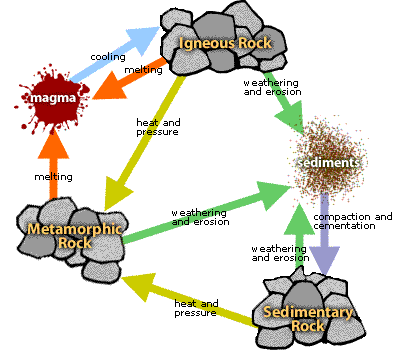Rock Cycle – Geology Notes – For W.B.C.S. Examination.
শৈল চক্র – ভূতত্ত্ব নোট – WBCS পরীক্ষা।
Erosion includes weathering (the physical and chemical breakdown of minerals) and transportation to a site of deposition. Diagenesis is, as previously explained, the process of forming sedimentary rock by compaction and natural cementation of grains, or crystallization from water or solutions, or recrystallization. The conversion of sediment to rock is termed lithification.The concept of the rock cycle is attributed to James Hutton (1726–1797), the 18th-century founder of modern geology. The main idea is that rocks are continually changing from one type to another and back again, as forces inside the earth bring them closer to the surface (where they are weathered, eroded, and compacted) and forces on the earth sink them back down (where they are heated, pressed, and melted). So the elements that make up rocks are never created or destroyed — instead, they are constantly being recycled. The rock cycle helps us to see that the earth is like a giant rock recycling machine!
Texture
The texture of a rock is the size, shape, and arrangement of the grains (for sedimentary rocks) or crystals (for igneous and metamorphic rocks). Also of importance are the rock’s extent of homogeneity (i.e., uniformity of composition throughout) and the degree of isotropy. The latter is the extent to which the bulk structure and composition are the same in all directions in the rock.
Analysis of texture can yield information about the rock’s source material, conditions and environment of deposition (for sedimentary rock) or crystallization and recrystallization (for igneous and metamorphic rock, respectively), and subsequent geologic history and change.
Please subscribe here to get all future updates on this post/page/category/website


 +919674493673
+919674493673  mailus@wbcsmadeeasy.in
mailus@wbcsmadeeasy.in







































































































